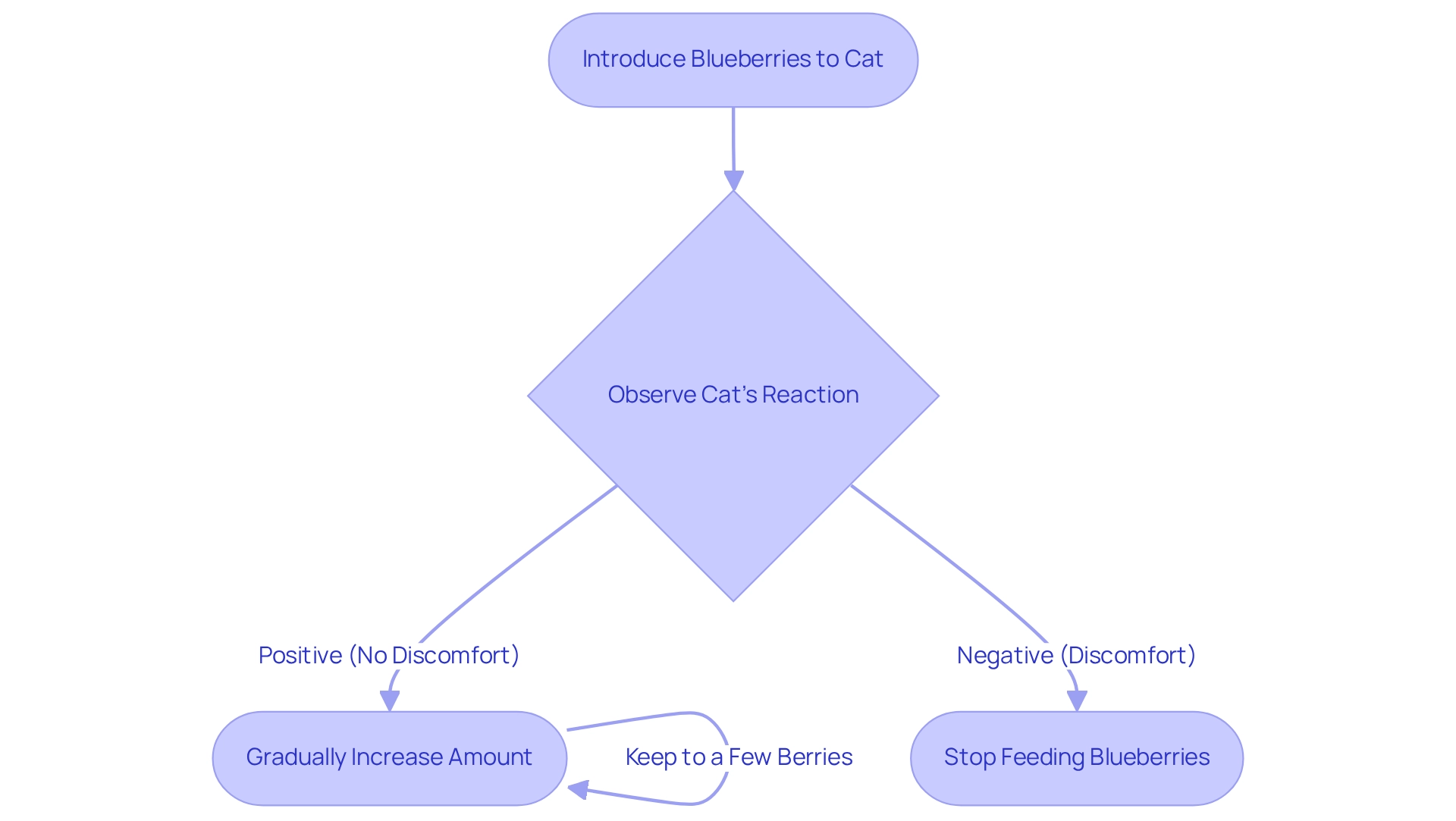Can Cats Eat Blueberries? Safe Introduction and Benefits
Overview
As a loving pet owner, you may wonder about the safety of certain foods for your furry family members. Good news! Cats can enjoy blueberries in small amounts, as they are generally non-toxic and provide wonderful nutritional benefits, including antioxidants and dietary fiber.
However, it’s essential to introduce blueberries gradually into their diet. By doing so, you can monitor for any adverse reactions, ensuring that this delightful fruit acts as a healthy supplement rather than taking center stage in their meals.
Remember, your cat’s well-being is our top priority, and with careful attention, you can enrich their diet while keeping them safe.
Introduction
In the quest for healthier treats for your furry family members, blueberries have emerged as a delightful option for cat owners. These vibrant berries are not only delicious but also offer a range of nutritional benefits that can enhance your cat’s well-being.
However, before introducing this fruit into your cat’s diet, it is crucial to understand its safety, nutritional value, and the proper methods for introduction. This article explores the essential considerations for offering blueberries to cats, ensuring that their health and safety remain our top priority while highlighting the advantages of this antioxidant-rich treat.
Determine the Safety of Blueberries for Cats
Before introducing blueberries to your furry family member, it’s essential to ensure their safety. Many people wonder if cats can eat blueberries, and the answer is that they are generally safe for cats to enjoy in small quantities. Various veterinary references confirm that these delightful little berries are non-toxic, leading to the question of whether cats can eat blueberries as a nutritious snack.
However, we understand that as a caring pet owner, you may have concerns about how your cat will react to new foods. Therefore, it’s important to observe your cat for any negative responses, especially if it’s their first time trying this fruit. Start by offering just one berry and watch your cat’s reaction closely. If there are no signs of discomfort or allergic reactions, you can gradually increase the amount, but always keep it to a few berries at a time. This way, you can ensure a safe and enjoyable experience for your beloved companion.

Explore the Nutritional Benefits of Blueberries
As a loving pet owner, you want the best for your furry family members, and you might ask, can cats eat blueberries as a delightful addition to their diet? These small, vibrant berries are packed with essential nutrients that can truly benefit your cat’s health, leading to the question of can cats eat blueberries? Rich in antioxidants, particularly vitamin C and flavonoids, they help combat oxidative stress and support a robust immune system.
Moreover, blueberries contain dietary fiber, which can assist in digestion, making them a wholesome treat. When offered in moderation, these fruits can enhance your cat’s overall health, providing a nutritious option that complements their diet, which raises the question: can cats eat blueberries?
However, it’s important to remember that felines are obligate carnivores, so plant-based items like blueberries should only serve to enhance their main diet of meat-based foods. By incorporating these berries thoughtfully, you can contribute to a nurturing environment that supports your beloved pet’s well-being.

Implement Safe Introduction Techniques for Blueberries
Introducing small berries to your beloved cat can be a delightful experience, making you wonder, can cats eat blueberries? To ensure their safety, follow these gentle steps:
-
Wash the Blueberries: Begin by rinsing them thoroughly to remove any pesticides or dirt. This simple act shows your care for your furry family member’s health.
-
Cut or Mash: If your cat is smaller or new to fruits, consider cutting the berry in half or mashing it. This makes it easier for them to enjoy.
-
Start Small: Offer just one berry at first. Take a moment to observe your cat’s reaction over the next few hours, as this will help you gauge their comfort level with this new treat.
-
Monitor for Reactions: Keep an eye out for any signs of digestive upset, such as vomiting or diarrhea. If your cat enjoys the fruit and shows no negative effects, you can gradually increase the amount, but remember to limit it to just a few berries each week, especially when considering whether can cats eat blueberries safely. By following these steps, you create a nurturing environment for your pet, ensuring they can safely enjoy the joys of new flavors.

Identify Health Concerns and Precautions
While these small fruits are generally safe for your furry family members, it’s important to consider a few health concerns. First and foremost, always ensure that the small dark fruits are fresh and free from mold. This simple step can help keep your pet healthy and happy.
Next, keep an eye on your cat for any signs of allergies, such as itching, swelling, or gastrointestinal upset. If your cat has a history of food sensitivities, it’s wise to consult your veterinarian before introducing berries into their diet. Your veterinarian can provide personalized advice to ensure your pet’s well-being.
Lastly, remember that fruits should only make up a small portion of your cat’s diet—ideally no more than 10%. This helps avoid any potential digestive issues. If you notice any adverse reactions after feeding blueberries, please discontinue use and reach out to your veterinarian. Your pet’s health is our top priority, and we want to support you in providing a nurturing environment for them.

Conclusion
Introducing blueberries into your furry family member’s diet can be a rewarding experience, provided that safety and moderation are prioritized. These delightful berries are generally safe for cats and offer a range of nutritional benefits, including antioxidants and dietary fiber, which can positively contribute to their health. However, it’s crucial to start slowly, keeping a watchful eye for any adverse reactions as your cat adjusts to this new treat.
Implementing safe introduction techniques, such as washing the fruit and starting with small portions, can help ensure a smooth transition. Remember, cats are obligate carnivores, so fruits like blueberries should only be offered in moderation, complementing their primary meat-based diet.
By being attentive to your cat’s reactions and adhering to recommended precautions, you can safely enrich their diets with this delicious and healthy treat. Ultimately, blueberries can be a fun and nutritious addition, enhancing the well-being of your beloved companions while ensuring their health remains the top priority.
Frequently Asked Questions
Can cats eat blueberries?
Yes, cats can eat blueberries in small quantities as they are generally safe and non-toxic.
How should I introduce blueberries to my cat?
Start by offering your cat just one blueberry and observe their reaction closely.
What should I do if my cat has a negative reaction to blueberries?
If your cat shows any signs of discomfort or allergic reactions, stop feeding them blueberries immediately.
How can I safely increase the amount of blueberries I give my cat?
If your cat has no negative reactions after the first blueberry, you can gradually increase the amount, but always keep it to a few berries at a time.
Why is it important to monitor my cat after introducing blueberries?
Monitoring your cat helps ensure that they do not have any adverse reactions to the new food, allowing for a safe and enjoyable experience.



